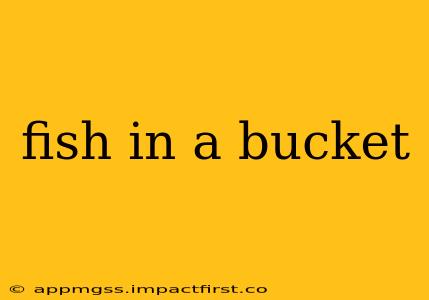Keeping fish in a bucket might seem like a simple task, but providing even temporary care requires understanding their needs. This guide covers essential aspects of short-term fish containment in a bucket, ensuring the well-being of your aquatic friends. Whether you're transporting fish, temporarily housing them during tank maintenance, or dealing with an emergency situation, understanding these guidelines is crucial.
Why Would You Keep Fish in a Bucket?
Several scenarios necessitate keeping fish in a bucket, albeit temporarily. These include:
- Transportation: Moving fish from one location to another, such as to a new aquarium or for veterinary care.
- Tank Cleaning/Maintenance: Providing a temporary holding area while cleaning or performing maintenance on their main aquarium.
- Emergency Situations: In case of a tank malfunction or disaster, a bucket provides a temporary safe haven.
- Quarantine: Isolating a sick fish to prevent the spread of disease to other fish.
What Kind of Bucket Should I Use?
The type of bucket matters significantly. Avoid using buckets that have previously held chemicals or toxic substances. A clean, food-grade plastic bucket is ideal. Ensure it's large enough to comfortably accommodate the fish, allowing for sufficient swimming space. Overcrowding is detrimental to their health.
What Size Bucket Do I Need?
The size of the bucket depends on the number and size of the fish. A good rule of thumb is to provide at least 1 gallon of water per inch of fish. For example, three 3-inch fish would require a minimum of 9 gallons of water. Remember, this is for temporary housing; a larger bucket is always better than a smaller one.
What Do I Need Besides the Bucket?
Simply placing fish in a bucket of water isn't enough. You'll need additional items to create a more suitable environment:
- Well-Aerated Water: Oxygen is crucial. Use an air pump with an airstone to ensure adequate oxygen levels. Without proper aeration, fish will suffocate quickly.
- Water Quality: Use dechlorinated water that is similar in temperature to the fish's original tank. Sudden temperature changes can stress and kill fish. Consider using a water conditioner to remove chlorine and chloramine.
- Appropriate Water Level: The water level should be high enough to comfortably submerge the fish, but not so high that they can't reach the surface for air, should they need to gulp air.
- Substrate (Optional): A small amount of gravel or smooth stones can provide a more natural environment. Avoid sharp objects.
- Shade: Direct sunlight can raise the water temperature significantly, leading to stress and death. Provide shade by placing the bucket in a cooler, dimly lit area.
How Long Can Fish Stay in a Bucket?
The duration a fish can safely remain in a bucket is highly dependent on several factors, including the size of the bucket, the number and size of the fish, the water quality, and the water temperature. Ideally, fish should only be kept in a bucket for a few hours at most. Longer periods require constant monitoring and maintenance of water quality and oxygen levels. For anything beyond a few hours, a larger temporary tank should be utilized.
What Happens if I Keep Fish in a Bucket Too Long?
Prolonged confinement in a small bucket leads to several problems:
- Oxygen Depletion: Fish consume oxygen, and in a confined space, oxygen levels can quickly drop to dangerous levels.
- Ammonia Buildup: Fish waste produces ammonia, which is highly toxic. In a bucket, ammonia accumulates rapidly, posing a serious threat to fish health.
- Stress: The cramped conditions and unstable environment cause considerable stress, weakening their immune system and making them vulnerable to diseases.
How to Safely Transfer Fish from a Bucket
When it's time to move the fish to their permanent habitat, do so carefully to minimize stress:
- Netting: Use a soft, fine-mesh net to gently scoop the fish out of the bucket.
- Acclimation: Gradually acclimate the fish to the new environment by floating the bucket in the tank for 15-30 minutes to equalize the water temperature. Slowly add water from the tank to the bucket over about an hour before releasing the fish.
Keeping fish in a bucket is acceptable only for short periods and requires diligent care. Prioritizing their well-being is paramount; remember that a bucket is a temporary solution, not a long-term housing option. Always strive to return them to a suitable aquarium environment as quickly as possible.
